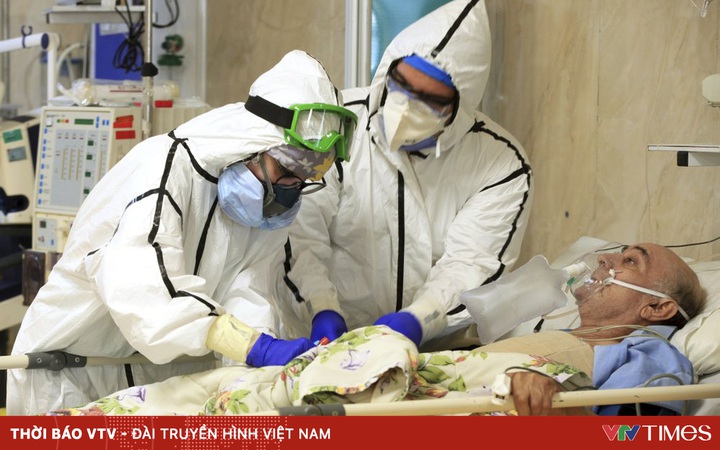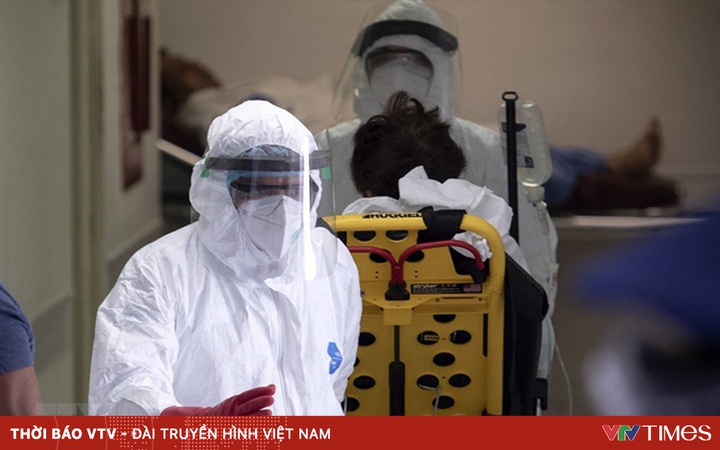Much of the world has lifted Covid-19 restrictions to live with the pandemic, but the outbreak is still taking its toll in many places.
When California issued a statewide stay-at-home order on March 19, 2020, most people thought life would soon return to normal. Two years later, people around the world are just starting to see a light at the end of the tunnel, with anti-epidemic restrictions being relaxed in the US and some other countries.
But with many places recording record numbers of infections, it’s clear that this pandemic isn’t ready to fall behind.
In the BrotherThe country’s last remaining Covid-19 restrictions, which require people to be quarantined after testing positive, were lifted late last month.

People queue for a vaccination in London, England, in January. Photo: Reuters.
It comes a month after the government scrapped recommendations to work from home whenever possible and asked people to wear masks in places like shops or on public transport.
Since last summer, the UK has had a much more lenient anti-epidemic policy than in other parts of the world. The requirement to wear a mask and work remotely will only be reintroduced at the end of 2021, when the Omicron variant takes effect.
The UK’s approach is based on the fact that vaccines provide a very good layer of protection for people and the vaccination rate in that country is also very high. 95% of people over 60 in the UK have had a booster shot.
Despite the trend of increasing numbers of infections due to the Omicron strain, the UK mortality rate remains low, similar to what is typically seen in a normal winter. There are signs that the infection rate is rising again, but for now there isn’t much to worry about.
south Africa Most have reopened. The government lifted most anti-epidemic regulations last December, ending a curfew and a ban on the sale of alcohol that had been in place for nearly two years. South Africa was one of the few countries to ban the sale of alcohol during the global outbreak in 2020.
Now, in the country’s cities and towns, life has returned to normal with a rush of busy people going to work and out. However, there are still signs that Covid-19 has not completely disappeared, as most people still comply with the mandatory requirement to wear masks in public places.
This change is reasonable because the number of infections has once again fallen after South Africa faced the fourth wave of Covid-19 a few months ago due to the Omicron mutation.
Most schools have reopened, but officials oppose the decision to make vaccinations mandatory at higher education institutions. Nightclubs are still closed, but people can now stay out late and hang out at bars without worrying about getting caught for violating the curfew.
Almost two years ago, New Zealand have handled the pandemic relatively well. The blockade orders and strict isolation regulations have turned the country into an effective anti-epidemic “bastion”. However, infection rates skyrocketed as restrictive measures were relaxed.
Many New Zealanders still cannot understand how their country went from 1,000 cases a day to 20,000 in just a few weeks. This comes shortly after Prime Minister Jacinda Ardern abandoned her “No Covid” strategy to find a way to live with nCoV.
One consolation amid the psychological shock is that New Zealand has only recorded 120 deaths from Covid-19 across the entire pandemic, thanks in large part to the population’s 95% vaccination rate.
Most of the restrictions have been relaxed and the isolation requirements for Covid-19 patients are no longer too strict.
But mandatory vaccination requirements have seen people who refuse vaccines in a number of jobs lose their jobs, sparking a wave of protests in the capital Wellington over the past three weeks that have not stopped.
New Zealanders who have received two injections can now return home from overseas without quarantine. Visitors from 60 countries, including the US and UK, will enjoy the same status from May 2 if their Covid-19 test result is negative.
In the Canadathe arrival of spring has not only melted winter ice but has also seen Covid-19 restrictions relaxed across the country.
With most anti-epidemic regulations now only within provincial government guidelines and not at the federal level, implementation has also become more lax.
Provinces and territories will abolish vaccine passports in April, but will still require workers in certain occupations, such as health care workers or nursing home workers, to show proof of vaccination. The rules for wearing masks are also gradually being lifted, including in schools.
Between states, people traveling by air and rail are still required to wear masks. People coming to Canada must also present a vaccination certificate and must be tested upon entry, at least for now.
The decision comes after weeks of protests against Covid-19 restrictions, which have paralyzed the capital Ottawa and one of Canada’s most important border crossings.

Protest against mandatory vaccination requirements in Windsor, Ontario, Canada, on Feb. 12. Photo: Reuters.
During most of the pandemic, Canada has adhered to strict anti-epidemic regulations. Some want the country to continue with this approach, but polls show a majority of Canadians want to end the restrictions.
At Georgetown University in Washington, America, the mask is now lying in the box, unused. It shows how Covid-19 containment restrictions have changed in the city as well as across the country.
Regulations now allow Americans to live almost as before the pandemic. Restrictive measures vary from place to place, but the general picture can be seen from a relatively free society.
Texas and Florida, two Republican-controlled states, have very few mask requirements. Even Democratic-controlled states, which used to have strict mask regulations, are gradually easing, going further than White House guidelines. New York and New Jersey have removed the requirement to wear masks in confined spaces, reflecting the government’s more confident stance before the pandemic.
While the US still leads the world in total deaths from Covid-19, the number of new cases per day has fallen to 36,000, from an average of 800,000 at its peak. Hospitalizations also fell by 75%, helping to lift the general atmosphere of the community. People want to return to normal life.
Silicia Lomax, an employee at a health policy consulting firm in Washington, said several months ago the subway line she used to work was empty. “But now it’s full,” he said.
But in other parts of the world, a new wave of Covid-19 has emerged and continues to spread pain. In the Hong KongOmicron mutations cause nightmares for this particular area.

Patients wear masks in an emergency ward outside a hospital in Hong Kong on March 2. Photo: Reuters.
During the first two years of the pandemic, the city adopted mainland China’s “No Covid” strategy, including strict border controls, proactive contact tracing and strict isolation. As of the end of last year, Hong Kong had only recorded a total of about 12,000 infections.
Currently, Hong Kong has the highest Covid-19 death rate per one million people in the world, with most of the victims being unvaccinated elderly people. More than half a million people in the city have been infected with the virus.
The virus is still spreading vigorously despite strict distancing measures. Restaurants are not allowed to provide food service after 6pm and places like gyms and bars have been closed since January.
This wave of death will eventually end. Most people will gain immunity after infection or vaccination. But many have questioned whether Hong Kong should continue to follow its “No Covid” strategy, as local businesses are struggling, while the tide of the epidemic is still rising.
China The mainland is also experiencing an increase in infections across the country due to the fast-spreading Omicron strain. The country has imposed blockade orders on a series of cities, but as of March 18 it still recorded 2,228 new nCoV cases, including 2,157 cases of community transmission, with 78% of cases in Jilin, the city that has implemented “no domestic exports, no foreign imports” measures. “Starting March 14th.
Thanks to implementing strict epidemic prevention policies under its “No Covid” strategy, China has recorded fewer than 5,000 deaths since the outbreak, most of which occurred during the first wave of Covid-19 in Wuhan at the end of the year. 2019.
Chinese officials see this as a demonstration of the superiority of their anti-epidemic policies and insist that they will continue to stick with their “No Covid” strategy.
Another place badly damaged by Covid-19 is Peru. The country quickly implemented blockade measures deemed the world’s most severe after the outbreak in 2020. The curfew made it impossible for dog owners to walk their pets.
But those efforts still failed to stop the pandemic from spreading and Peru’s hospital system was overwhelmed. In order to make a living, people in this impoverished country cannot stop working for too long, coupled with the fact that public health services are inadequate, making it difficult for Peru to contain the pandemic, which is causing a spike in the death toll.
But two years have passed and it seems that Covid-19 has become a part of everyday life in Peru. Restrictions are being relaxed and infection rates have fallen. Even so, masks are still needed in many places and the public is still required to show proof of vaccination when entering public places.
at Blogtuan.info – Source: vnexpress.net – Read the original article here



